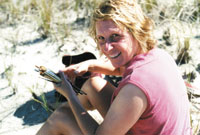Our Changing World:
Really Good Crappy Ideas
[We include this article because it may be of particular interest to Cape home-owners since few sewer systems exist on the Cape and most houses have Title V septic systems. Sent to us by our good friend Mary Stack, who says, “From my good friend Carl whose Dad invented the Clivus Multrum” ]
We all produce a rich resource in our homes and then spend millions of dollars to throw it away. A new movement says there are smarter ways to think about waste.
IN A WORLD OF rapidly diminishing resources, there's one we tend to overlook. It's easy to produce and extremely abundant. But instead of viewing it as an embarrassment of riches, we're more likely to see it as just an embarrassment.
This neglected treasure is human waste. Urine is rich in nitrogen, potassium, and phosphorus, the three main ingredients in artificial fertilizer. Feces contains these nutrients, too, in smaller doses, and the methane it produces can be harnessed as biogas, a green energy source.
Yet in most cultures, understandably, the first impulse is not to use waste wisely, but to get rid of it as quickly as possible. In many rural, undeveloped areas, people simply "go" in the bush, or by the closest river. In advanced industrialized societies, we flush it away.
Both methods—and several others between the extremes—pose problems that grow more conspicuous every day. As the developing world has grown more crowded and urban, the lack of adequate sanitation has become a public health crisis. In America and other developed countries, the system works much more smoothly, but uses enormous quantities of clean water— about 4,000 gallons per person each year—and requires massive amounts of energy and money to treat the resulting sewage.
But now a growing global movement aims to make sanitation more sustainable by changing how both rich and poor countries think about human waste—recasting it as a valuable resource that is most costly when thrown away. Following a philosophy known as ecological sanitation, or "ecosan," and fueled by a convergence of factors—the rising prices of energy and artificial fertilizer, increasing worries about food security, and concern for the environment—the push to reform sanitation has gained currency around the world, driving innovations from toilet design to farming practices. And some sanitation reformers say they are even making headway into the most vexing question: How to get people to see promise in a substance they are taught from birth to find revolting.
" There's been a lot of resistance and disbelief that anything like this can work," says Mayling Simpson-Hebert, a technical adviser with Catholic Relief Services in East Africa. "That seems to be changing."
Simpson-Hebert has helped to introduce a toilet called the arborloo— in which a fruit tree seedling is planted in a waste-filled pit— to thousands of Ethiopian farmers in the past few years. Numerous other projects are underway in the rest of the developing world. And the idea has started to gain traction in the developed world as well. In Europe, recent years have seen the advent of "urine diversion" toilets, which separate the two kinds of waste in order to treat it more efficiently, among other benefits. Locally, a private school in Weston has installed flushless compost toilets manufactured by Clivus Multrum, a company based in Lawrence. And several European pilot projects have begun to experiment with vacuum-biogas toilets, which require very little water and turn waste into energy.
From Boston.com | continued at crappyidea.pdf
The Environment
The Nature of the Cape
By Mary Richmond
I CANNOT STAY inside. Every day I must walk outdoors. It doesn’t matter if it’s down an ocean beach or along a quiet pond path. It can be along the side of a salt marsh or along a sunny meadow filled with birds, butterflies, flowers and rabbits. My walk can take me through a sun dappled woodland or through a swamp filled with the buzz and glitter of dragonflies. What matters is that it’s outside. What matters is that I am free, unbound by boundaries and walls. I can feel the sun on my back, the rain on my face, the droplets of fog on my hair, the wind or the lack thereof. Nature always has a surprise waiting for me and each day I am eager to find out what it is.

It doesn’t really take much to feel a part of nature, even if you’re stuck behind a desk or the steering wheel of a car most days. Even being outside in your yard will allow that open feeling of no roof over your head, no doors to open or close. Shut off your cell phone, forget about what you’re making for dinner and join me as I take a walk around a pond. It’s a pond like the one you might have explored as a child. There are branches overhead as I begin down the path, and lots of poison ivy. The ivy is strong and big this year and many plants are full of green berries that will soon be turning white. I don’t let this bother me; I just stay on the path and continue on.
Cardinals are chipping and calling in the branches above me. Two young birds are following their parents, hoping for handouts but the parents are teaching them to fend for themselves. A large family of chickadees is feeding in a bush nearby. There are almost a dozen of them, moving quickly through the branches, catching tiny spiders and insects as they move. A rabbit stands by the side of the trail, assessing whether I am a danger or not. I stand and watch it sniff the air and turn its head from side to side as it decides it is safe to continue eating the flower it has snapped off at the base. It chews the stem from the bottom up, nose wiggling, eyes wide. It hears something, drops the flower and moves into the underbrush. I walk on by as the two quarreling chipmunks that have disturbed the rabbit race by me close enough to almost run over my foot in their haste.
The pond is still full of blooming water lilies and along the edge are frogs of all sizes and shapes. The new frogs, those that have just emerged from their lengthy stay underwater as tadpoles, still have bits of tail that they will soon absorb. They are tiny and fresh and are innocent of the fact that the big old bullfrog sitting a few feet away would be happy to eat one of them for dinner. This time the old frog is more interested in the mating dragonflies that are buzzing around in front of his nose. He opens his big mouth and they are gone.
The water sparkles with light and I hear the tell-tale rattle of a kingfisher as it flies by. There is a whole family of them using this pond as their fishing ground and as I scan the trees with my eyes I spot at least two more in the branches nearby. Mom and dad will spend most of the day teaching them to fish; the young will follow them with their eyes and beg for the fish that they will catch. There are no more free lunches for these guys, however, and as I watch one of them makes a clumsy dive into the water. It catches no fish this time, though, and returns to its branch to shake out its feathers and complain a little more.
Swallows turn and twist in the air just over the surface of the pond. They are eating dragonflies, mosquitoes and all sorts of flying insects. Their precision is amazing. Young swallows stand by on another branch and I can almost hear them thinking, “You want me to go fly out there with my mouth open and catch bugs? What are you, nuts?” This is the time of year when many young birds seem to be thinking that thought. Imagine being a young osprey or other young hawk. They must look at the young sparrows which just have to find some seeds and think they got the short end of the stick.
. . . . . . . . . . . . . . . . . . . . . .
CapeWomenOnline.com
P. O. Box 720, North Eastham, Cape Cod, MA 02651 | Telephone: (508) 255-5084
Gillian Drake, Publisher
Gillian@CapeWomenOnline.com
Nicola Burnell, Editor
Nicola@CapeWomenOnline.com
© Copyright 2008 CapeWomenOnline
All rights reserved
Return to top of page
Many painted turtles are piled on a log in the sun. Their black heads all turn in unison to watch me walk by. I watch for the big snapping turtle I sometimes see here. I have to carefully look into the water for snapping turtles don’t bask like these painted turtles do. You may see them just below the surface with their big heads just poking out of the water as they move slowly through the water. The water willow is in bloom with its lovely pink blossoms even as the spiky purple pickerel weed is beginning to fade. There is lots of spicebush here as well, filling the air with its strong sweet perfume. Mushrooms are beginning to pop up on the woodland floor around the pond and the carpet moss is bright green and inviting in its luxurious softness. A yellow warbler stops in a bush just ahead of me, its bill jammed full of caterpillars. It watches me and I watch it. It is so tiny and so perfect, so very fierce and alive.
There is no better way to spend the day than this, watching, listening, smelling, feeling. The world opens up even as I just stand and take it all in. A young ribbon snake moves off to my side and I watch it disappear into the brush. It is only a moment and it is gone. I hear voices in front of me and as a group of chatty people pass me by I know they have missed the snake and the warbler. Oh well, it is time for me to go back inside and get some work done but the sights and sounds and smells of this afternoon walk will be with me the rest of the day.

Mary Richmond is an artist, writer and naturalist
and educator who grew up in Hyannis and works all around Cape Cod. She is most happy when she is outside. She writes and illustrates a weekly column, “Nature’s Ways” for The Cape Codder and The Register and another weekly column, “Weekly Nature Watch” for the Enterprise Newspapers on the Upper Cape. Her monthly column, “Neighborhood Nature” appears on the third Friday of the month in the Barnstable Patriot. You may see some of her artwork at www.maryrichmonddesign.etysy.com
www.maryrichmonddesign.typepad.com
send comments to: comments@capewomenonline.com
. . . . . . . . . . . . . . . . . . . . . . .
SUSTAINABILITY TIP OF THE WEEK:
MICRO-GENERATION
AND MICRO-FARMING
As energy and food prices continue to rise, global experts predict that micro-generation and micro-farming will boom over the next few years. New trends in urban farming, like vertical gardening and backyard chickens, can help feed households in an economical and earth friendly way. New technologies in micro-generation, powering your home with a wind turbine or solar paneling, for example, are making off-the-grid living more financially feasible than ever. In fact, priorities in Silicon Valley are already shifting from developing better microchips towards focusing on thin-film solar cells. Meanwhile, programs like 'Solar City' are offering 20% savings in solar paneling installations for neighborhoods who buy in bulk.
Learn more: www.organicconsumers.org


